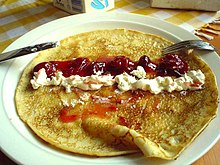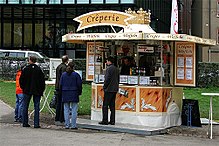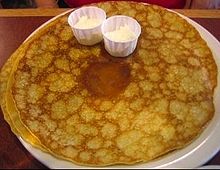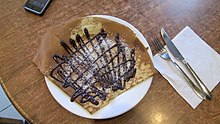Crêpe
hideThis article has multiple issues. Please help or discuss these issues on the talk page. (Learn how and when to remove these template messages)
|
 A stack of crêpes | |
| Alternative names | Crepe |
|---|---|
| Type | Pancake |
| Place of origin | Brittany |
| Serving temperature | Warm, hot or cold |
| Main ingredients | Wheat flour or buckwheat flour, milk, eggs |

A crêpe or crepe (/kreɪp/ (![]() listen)[1] or /krɛp/, French: [kʁɛp] (
listen)[1] or /krɛp/, French: [kʁɛp] (![]() listen), Quebec French: [kʁaɪ̯p] (
listen), Quebec French: [kʁaɪ̯p] (![]() listen)) is a type of very thin pancake. Crêpes are usually of two types: sweet crêpes (crêpes sucrées) and savoury galettes (crêpes salées). Crêpes are served with a variety of fillings, from the simplest with only sugar to flambéed crêpes Suzette or elaborate savoury galettes. Crêpes originate in Brittany, a region in the west of France; the consumption is widespread in France, Belgium, the Netherlands, Canada, and many parts of Europe, North Africa, North America, Lebanon, Mexico, Brazil, Argentina, and India.
listen)) is a type of very thin pancake. Crêpes are usually of two types: sweet crêpes (crêpes sucrées) and savoury galettes (crêpes salées). Crêpes are served with a variety of fillings, from the simplest with only sugar to flambéed crêpes Suzette or elaborate savoury galettes. Crêpes originate in Brittany, a region in the west of France; the consumption is widespread in France, Belgium, the Netherlands, Canada, and many parts of Europe, North Africa, North America, Lebanon, Mexico, Brazil, Argentina, and India.
Etymology[]
The French term "crêpe" derives from the Latin crispa, meaning with "creases". The name "galette" came from the French word galet ("pebble") since the first galettes were made on a large pebble heated in a fire.
Traditions[]
In France, crêpes are traditionally served on Candlemas (La Chandeleur), February 2. This day was originally Virgin Mary's Blessing Day but became known in France as "Le Jour des Crêpes" (literally translated "The Day of the Crêpes", and sometimes called colloquially as "Avec Crêpe Day", "National Crêpe Day", or "day of the Crêpe"), referring to the tradition of offering crêpes. In fact, in 472 Roman Pope Gelasius I offered Crispus (later said Crêpes) to French pilgrims that were visiting Rome for celebrating the Chandeleur.[2] Also, the belief is that catching the crêpe with a frying pan after tossing it in the air with the right hand while holding a gold coin in the left hand will make that person rich for a year.[3][4] The roundness and golden color of a crêpe resemble the sun and its rays. This symbolism also applies to the coin held in the person's hand.[5]
Types of crêpe[]
Sweet crêpes are generally made with wheat flour (farine de blé). When sweet, they can be eaten as part of breakfast or as a dessert. Common fillings include Nutella spread, preserves, sugar (granulated or powdered), maple syrup, golden syrup, lemon juice, whipped cream, fruit spreads, custard, and sliced soft fruits or confiture.
Savory crêpes are made with non-wheat flours such as buckwheat. A normal savory crêpe recipe includes using wheat flour but omitting the sugar.[6][citation needed] Batter made from buckwheat flour is gluten-free, which makes it possible for people who have a wheat allergy or gluten intolerance to eat this type of crêpe. Common savoury fillings for crêpes served for lunch or dinner are cheese, ham, and eggs, ratatouille, mushrooms, artichoke (in certain regions), and various meat products.
Crêpes can also be made into crepe cakes by adding the plain crepes on top of each other, and within the two layers adding a layer of cream. Fruits, chocolate, cookies, marshmallow, etc, can be added. Most of the crêpe cake is sweet and it is usually considered as a dessert. It can also replace the traditional birthday cake. Crêpe cakes are usually 15-30 layers, and the crêpes used are very thin and soft.[citation needed]
Batters can also consist of other ingredients such as butter, milk, water, eggs, flour, salt, and sugar.[7] Fillings are commonly added to the center of the crêpe and served with the edges partially folded over the center. An Indian variety of the crêpe uses a multi-grain flour called "bhajanee", eggs, curd, and an assortment of spices as its ingredients. It is a modern variation of an Indian dish called Thalipeeth.[citation needed]
A cake made with layers of crêpes with a filling in between is called “ミルクレープ(mille-crêpes)”, a Japanese-made French word combining crêpes and mille-feuille.[8] It was invented by Emy Wada, a pâtissier who operated Paper Moon Cake Boutiques in Japan, in 1980s. In 2001, she expanded to New York City where she supplied cakes to popular chains Dean & Deluca and Takashimaya.[9] Today mille-crêpes are often introduced as a French pastry in many parts of the world despite its Japanese origin and can even be found in France.[10][11][12]
Making batter[]
In order to make an evenly thin crêpe, it is crucial to have a batter without lumps. After whisking the batter, let it rest for half an hour, or overnight, to let the bubbles from whisking disappear from the batter. Some people mix the batter to a fine consistency by using a blender or mixer.[13]
Crêperies[]


A crêperie may be a takeaway restaurant or stall, serving crêpes as a form of fast food or street food, or may be a more formal sit-down restaurant or café.[14]
Crêperies are typical in France, especially in Brittany; however, crêperies can be found throughout France and in many other countries.
Because a crêpe may be served as either a main meal or a dessert, crêperies may be quite diverse in their selection and may offer other baked goods such as baguettes. They may also serve coffee, tea, buttermilk, and cider (a popular drink to accompany crêpes).[15]
Special crêpes[]
This section needs additional citations for verification. (February 2015) |

Mille crêpes(ja) are a French cake made of many crêpe layers. The word mille means "a thousand", implying the many layers of crêpe.[16] Another standard French and Belgian crêpe is the crêpe Suzette, a crêpe with lightly grated orange peel and liqueur (usually Grand Marnier), which is subsequently lit upon presentation.[17]
English pancakes are similar to wheat flour crêpes and are served with golden syrup or lemon juice and sugar. Swedish pancakes, also called Nordic pancakes, are similar to French crêpes. In some of the Nordic countries, crêpes are served with jam or fruit, especially lingonberries (or the butter from that fruit) as a dessert with a variety of savory fillings. Traditional Swedish variations can be exotic. Besides the usual thin pancakes, called pannkakor in Swedish and räiskäle in Finnish which resemble the French crêpes and, often served with whipped cream and jam, are traditionally eaten for lunch on Thursdays with pea soup. The Swedish cuisine (as well as the Finnish one) has plättar/lettu, which resemble tiny English pancakes, are fried several at a time in a special pan. Others resemble German pancakes but are baked in the oven and include fried pork in the batter (fläskpannkaka). Potato pancakes called "raggmunk" contain shredded raw potato and may contain other vegetables (sometimes the pancake batter is omitted, producing rårakor).
A special Swedish pancake is the saffron pancake from Gotland which is made with saffron and rice and baked in the oven. It is common to add lemon juice to the sugar for extra taste. The pancakes are often served after a soup. Another special Swedish pancake is the äggakaka (eggcake), also called skånsk äggakaka (Scanian eggcake).[18] It is almost like an ordinary Swedish pancake but it is much thicker and more difficult to make due to the risk of burning it. It is made in a frying pan and is about 1+1⁄2 to 2 inches thick and is served with lingonberries and bacon. The Norwegian variety is commonly eaten for dinner, traditionally with bacon, jam (typically bilberry jam) or sugar.[citation needed]

The 49er flapjack is a sourdough crêpe which is popular in the United States,[19] getting its name from the popularity of this style of pancake during the California Gold Rush. Because it is similar to a Swedish pancake, the 49er is sometimes served with lingonberry sauce, although most often it is rolled up with butter and powdered sugar, or served open-faced and topped with maple syrup.
Cherry Kijafa Crêpes are also common in the United States and are made with a traditional crêpe base, but filled with cherries simmered in a Kijafa wine sauce.[20]
Crêpe dentelle is a crispy biscuit made with a very thin layer of crêpe folded in a cigar shape and then baked. It is usually enjoyed with a hot drink during the goûter, in France.[21]
Crêpes in European culture[]



In Norwegian, crêpes are called pannekake, in most German regions Crêpes (referring to a wide and flat crêpe, as opposed to the smaller and thicker native Pfannkuchen pancakes). In Swedish, a crêpe is called pannkaka in southern regions while being called plättar in the north, in Danish, pandekager ("pancakes"), in Icelandic it is called pönnukaka, in Finnish a crêpe is called either ohukainen or lettu or räiskäle, in Greek it is krepa (Κρέπα), in Dutch it is a pannenkoek or flensje, and in Afrikaans a pannekoek, which is usually served with cinnamon and sugar. In the Spanish regions of Galicia and Asturias, they are traditionally served at carnivals. In Galicia, they're called filloas, and may also be made with pork blood instead of milk. In Asturias, they are called fayueles or frixuelos, and in Turkey, akıtma.
In areas of central Europe, formerly belonging to the Austro-Hungarian empire, there is a thin pancake comparable to a crêpe that in Austro-Bavarian is called Palatschinken; in Hungarian: palacsinta; and in Bulgarian, Macedonian, Czech, Serbo-Croatian, and Slovene: palačinka; in Slovak: palacinka. In the Balkan countries, palačinka or pallaçinka may be eaten with fruit jam, quark cheese, sugar, honey, or the hazelnut-chocolate cream Nutella, while there is also a breaded variant which is mostly filled with meat. Restaurants which are specialised in palačinci are called "Palačinkara" in the region. In Ashkenazi Jewish cuisine, there is a similar dish known as the blintz. The Oxford English Dictionary derives the German and Slavic words from the Hungarians palacsinta, which it derives from the Romanian plăcintă, which comes in turn from classical Latin placenta ("small flat cake"), even though the Romanian plăcintă is more similar to a pie, and the crêpes are actually called clătită.
During the Russian celebration of Maslenitsa (Russian Butter Week), one of the most popular foods are blini, or crêpes. Since they are made from butter, eggs, and milk, crêpes are allowed to be consumed during the celebration by the Orthodox church. White flour can be replaced with buckwheat flour and milk can be switched for kefir, and oils can be added or substituted. Blini are served with a piece of butter and topped with caviar, cheese, meat, potatoes, mushrooms, honey, berry jam, or often a dollop of sour cream. The dish is supposed to represent the sun since the holiday is about the beginning of the spring.[22]
In addition to crêperies and crêpe franchises, some crêpe manufacturers use modern equipment to produce crêpes in bulk.

The names for thin crêpes in other parts of Europe are:
- Albanian: pallaçinka
- Asturian: frixuelo
- Breton: krampouezh
- Bulgarian: палачинка
- Cornish: krampoeth
- Czech: palačinka
- Dutch: pannenkoek
- Estonian: pannkook, ülepannikook
- Faroese: pannukaka
- Finnish: ohukainen, lätty, lettu or räiskäle
- Galician: filloas
- German: Crepe, Austria: Palatschinke
- Greek: κρέπα (krépa)
- Hungarian: palacsinta
- Icelandic: pönnukaka
- Italian: crespella, crespe
- Kazakh: құймақ (quymaq)
- Latvian: pankūka
- Lithuanian: lietiniai blynai
- Macedonian: палачинка
- Polish: naleśniki
- Portuguese: crepe
- Romanian: clătită
- Russian: блины (bliny)
- Serbo-Croatian: palačinka, палачинка
- Slovak: palacinka
- Slovene: palačinka
- Spanish: crepes
- Turkish: krep, akıtma
- Ukrainian: млинці, налисники (mlyntsi, nalysnyky)
- Welsh: cramwyth
Crêpes outside of Europe[]
In South India, a crêpe made of fermented rice batter is called a dosa, which often has savory fillings. In Western India, a crêpe made of gram flour is called "Pudlaa" or "Poodla", with the batter consisting of vegetables and spices. Another variety is called "patibola" and is sweet in taste due to milk, jaggery, or sugar. The injera of Ethiopian/Eritrean/Somali/Yemeni cuisine is often described as a thick crêpe. In Somalia, Malawaḥ (Somali: Malawax) is very similar to a crêpe. It is mostly eaten at breakfast.
Crêpes have also long been popular in Japan and Malaysia, with sweet and savory varieties being sold at many small stands, usually called crêperies. In Argentina and Uruguay, they are called panqueques and are often eaten with dulce de leche. Various other French foods such as crêpes, soufflés, and quiche have slowly made their way into North American cooking establishments.[23] Typically, these franchises stick to the traditional French method of making crêpes but they have also put their own spin on the crêpe with new types such as the hamburger and pizza crêpe.
In Mexico, crêpes are known as crepas, and were introduced during the 19th century by the French[24][25] and are typically served either as a sweet dessert when filled with cajeta (similar to dulce de leche), or as a savoury dish when filled with Huitlacoche (corn smut), which is considered a delicacy.
In the Philippines, a native crêpe recipe is the daral which is made from ground glutinous rice and coconut milk batter (galapong). It is rolled into a cylinder and filled with sweetened coconut meat strips (hinti).[26]
See also[]
- Bánh xèo
- Blintz
- Brik
- Crêpe bretonne
- Crepe maker, crepe cooking device
- Dosa
- Galette, another kind of Breton pancake, also from Brittany, France
- Injera
- Jianbing, a traditional Chinese street food similar to crepe
- Kue leker, a traditional Indonesian crepe
- Kouign amann, another Breton delicacy
- Krampouz, crepe maker manufacturer, also from Brittany, France
- List of brunch foods
- List of pancakes
- Maslenitsa
- Memiljeon
- Oreilles d'âne, made with wild spinach
- Palatschinken
- Pancake Day
- Pek Nga, Malaysian crepe-like snack
- Popiah, Chinese roll wrapped in a thin crepe made by "wiping" dough on a hot plate
- Ploye, a buckwheat pancake originating from Acadian cuisine of Canada
- Poffertjes, small ball-shaped pancake that is popular in the Netherlands
- Roti prata
- Sope
- Swedish pancake
- Tava
References[]
- ^ Longman Pronunciation Dictionary. 3rd Ed. 2008.
Merriam-Webster Dictionary - ^ "La Chandeleur: The Day to Flip Crêpes". France-Amérique. 29 January 2020. Retrieved 10 February 2021.
- ^ Clay, Xanthe (17 February 2007). "With a flame in your art". The Daily Telegraph. London. Retrieved 25 April 2008.[dead link]
- ^ Hum, Michelle (30 January 2012). "La Chandeleur – Le Jour des Crêpes". A Woman's Paris. Retrieved 10 February 2021.
- ^ Sokolov, Raymond. "Sun food." Natural History May 1993: 82. Academic Search Complete.
- ^ Alfaro, Danilo. "Sweet or Savory Basic Crepe Recipe". The Spruce Eats. Dotdash. Retrieved 3 April 2020.
- ^ "Wrap it up in a crêpe; Thin pancakes work in savory or sweet dishes." Times-Colonist (Victoria, British Columbia). (24 April 2013 Wednesday) LexisNexis Academic.
- ^ "Invented Overseas, Reinterpreted in Japan: Unique Japanese Sweets with International Roots | LIVE JAPAN travel guide". LIVE JAPAN. Retrieved 26 February 2021.
- ^ "Gâteau de Crêpes (Crepe Cake)". The Little Epicurean. 15 September 2011. Retrieved 26 February 2021.
- ^ "The History of Crêpes | Institute of Culinary Education". www.ice.edu. Retrieved 26 February 2021.
- ^ "Mille crepe ミルクレープ". Chopstick Chronicles. 27 September 2016. Retrieved 26 February 2021.
- ^ "Meet the inventor of the mille crepe". The Manila Times. Retrieved 26 February 2021.
- ^ "Finding the Best Way to Make Crêpes with Fluid Dynamics Research". 6 November 2019.
- ^ "La Creperie Cafe". Retrieved 3 December 2012.
- ^ "La Creperie Key West". Archived from the original on 5 November 2012. Retrieved 3 December 2012.
- ^ Hesser, Amanda (15 May 2005). "The Way We Eat: Building a Modern, Multistoried Dessert". The New York Times.
- ^ Courtine, Robert J. (1984), Larousse gastronomique (French edition), Paris: Librairie Larousse.
- ^ "Skånsk egg cake". Swedish Food.com. Retrieved 3 April 2020.
- ^ "Why They Sell Like Hot Cakes". Los Angeles Times. 16 March 1995. Retrieved 19 October 2018.
- ^ "The Original Pancake House Crepes". The Original Pancake House Home Page. Retrieved 10 February 2021.
- ^ "lace crepes". Archived from the original on 21 December 2012. Retrieved 4 December 2012.
- ^ Nesterova, Maria (24 February 2014). "Maslenitsa, another Russian festival you've probably never heard of". Eurokulture.missouri.edu. Retrieved 19 October 2018.
- ^ Benenson, R. (1984). Dining in America. Editorial research reports 1984 (Vol. I). Washington, DC: CQ Press.
- ^ Fernández-del-Villar, Miguel Angel and Ruiz-Naufal, Víctor M., Mesa Mexicana (1993), Fundación Cultural Bancomer, ISBN 9789686084948
- ^ Hursh, Karen (1 February 2005). "The French Influence On Mexican Cooking". Mexconnect.com. Retrieved 19 October 2018.
- ^ Polistico, Edgie. "daral". Philippine Food Illustrated. Retrieved 15 January 2020.
Sources[]
- 19. Life A La Henri – Being The Memories of Henri Charpentier, by Henri Charpentier and Boyden Sparkes, The Modern Library, New York, 2001 Paperback Edition. Originally published in 1934 by Simon & Schuster, Inc.
External links[]
 Media related to Crêpe at Wikimedia Commons
Media related to Crêpe at Wikimedia Commons The dictionary definition of crêpe at Wiktionary
The dictionary definition of crêpe at Wiktionary Crêpe at Wikibook Cookbooks
Crêpe at Wikibook Cookbooks- How to make a crepe
- Pancakes
- Belgian cuisine
- Breton cuisine
- Desserts
- European cuisine
- French desserts
- Snack foods
- Street food
- National dishes

